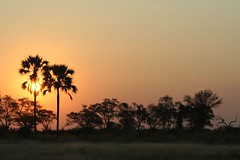
Click on pic to see slideshow
or here to access the set
Waking up to the sight of fresh elephant dung five feet away from the tent, would make anyone pause for a second and reflect upon the mysterious coincidences of life. What was I doing while the elephant was peacefully going about its business, walking slowly on the edge of our camp? Did the lions come by too? What if I had woken up at that same time and walked outside to complete a business similar to that of the elephant? How would this untimely meeting between man and beast have taken place? Alas, I will not know the answers to those unsettling questions and I’ll have to find satisfaction in my tamer memories of our trip to the Okavango delta, Botswana’s number one tourist attraction.
The Okavango River, after running for one thousand miles through Angola, Namibia and Botswana spreads into a maze of shallow waterways over some 15,000 square kilometers of the Kalahari Desert, and brings it to life. The river has no outlet to the sea and flows into a caldera that used to be the lake Makgadikgadi long ago. There’s nothing left of the lake and the river arms spread across the land and lose themselves in a maze of shallow-water ponds, covered by thriving high grasses. These ponds are too shallow for navigation except by mokoro – the traditional, flat-bottom dug-out canoes of the locals, which nowadays, more often than not, are made of fiberglass. The mokoros make their way across the water, leaving short-lived paths through the grass in their wake. They are pushed by their skilful polers who stand up straight in the boats and keep their balance without effort, talking to one another – sometimes, I think, they make jokes about us. But steering the mokoro is no trivial task – I tried twice and both times I lasted for just one minute before losing my balance, falling overboard and flooding the canoe with a screaming Angela and the laughing poler in it.
The delta, where for two nights we camped on a patch of dry land together with our local guides, abounds in wildlife, but it’s more common to see traces, leftovers and bones than the living animals. We followed an elephant once, spotted some antelopes and wildebeest, saw the eyes of a hippopotamus bulging above the water, but in the end the real fascination is in the place itself, the spectacular remoteness, the peculiar mix of desert and water and the mokoros gliding gently above the yielding grass.
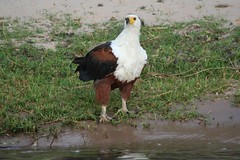
Click on pic to see slideshow
or here to access the set
In contrast, our other tourist stop in Botswana, the Chobe river National Park, does not offer the off-the-beaten track experience like the delta, but it compensates by the large number of wild animals that can be spotted in a short three-hour boat cruise. The river banks at the edge of the park are littered with high-end tourist lodges, the town is not far, and many speed-boats of various sizes carry loads of tourists among the river’s islands in search for the best picture spots. We took a small 12-person boat, but the one that left the pier right before us was a gigantic catamaran, occupied by a boisterous pack of sweating Russians, with a full bar lined up with all that is needed for any self-respecting partying Russian. There’s a river ride for each taste and budget, from the grubby backpackers on a budget to the retired Americans blowing their 401k savings on their dream trip, the one they never had time to take in a lifetime of hard work, taking care of demanding children, and two-week-a-year vacations they chose to spend at their in-laws house.
The riverbanks are crowded with animals; after spotting elephants wallowing in mud, one doesn’t need to go too far to see hippos grazing. Crocodiles lie motionless on the beaches with their mouths open, regulating the temperature of their reptilian cold-bloodied bodies. Eagles and antelopes, lizards and buffalos, lions and pachyderms share this unlimited supply of water and food. Some are food for the others, but they don’t seem to mind; the benefits for the species outweigh the disadvantages of natural selection. They all fell prey to our hungry cameras, but getting the national-geographic wildlife shot is not easy: the subjects are moving, their colors are often blending into the environment, and the sun is rarely coming from the right angle. Besides, all organized tours seem to have a propensity for taking tourists to see and photograph the sunset over a famous sight. African dusks are beautiful, the huge orange ball of fire sinking over the savanna, but otherwise they make for lousy pictures of anything else than the sunset itself. We still have four African countries to cross - my wildlife pictures will have to get better!
Posted from Livingstone, Zambia


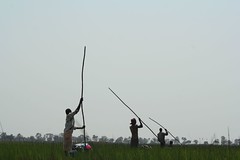
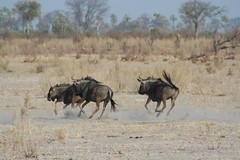
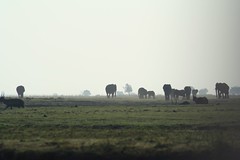

No comments:
Post a Comment